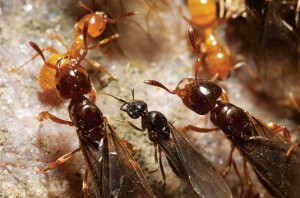Q: Citronella ants (Acanthomyops spp.) are swarming in an operating room (OR) at a local hospital. What can I do about them? The OR is currently shut down. —Richard H., New Hampshire
A: Citronella ants nest in the soil. I’d try to determine how they got to the OR, and then seal off any cracks or crevices they might have used to enter. The only other option I know of is to install an insect light trap (ILT) temporarily to collect them. Insecticides will not stop swarmers from entering, so you don’t need
to use any.
Q: A leaking waste pipe under a slab developed a drain fly (Psychodidae) infestation. The leak was located and repaired. The contaminated soil was removed, although I wasn’t present to see it. A new slab was poured. Two weeks later, a few drain flies were noted. One or two a day were found by the homeowner. Now what? The foundation-slab joint is under the wall beneath the kitchen cabinets and can’t be reached. I believe that’s the entry point for the flies. Is there anything I can do, and how long might this problem persist? —Tom S., Michigan
A: I always like to be present when a contractor removes the contaminated soil. Contractors usually don’t know how far to dig. Apparently in this case, some contaminated soil remains. The length of time the problem will persist depends on how much contaminated soil is present. It might just be a few weeks, or it could be longer. There’s no way to predict that.
In the interim, you might try getting a pyrethroid under the cabinets so you can kill any flies as they come through the cold joint. A dust would be preferable to obtain the best coverage.
Q: A hospital has carpenter ants (Camponotus spp.) showing up in several patient rooms. I have baited and eliminated the ants from two rooms. Then the janitorial staff caulked all seams in the area. This apparently disturbed the ants’ normal habits, and they ceased accepting baits. The area has a flat roof — and I suspect moisture conditions have created a nesting site in the roof. I can’t use any residuals in these rooms. What do you suggest? —Dave C., New York
A: There are several things you can try. Change the baits and see if they’re accepted. Use gel baits if possible. Use one of the green non-residuals to knock down stray ants. If this fails, you might have to have the rooms in question evacuated so you can drill into the ceiling and treat any voids above. You’ll also need to have a discussion with hospital administration to prevent others from interfering with your programs in the future.
Q: A county agent identified insects accumulating in a trailer park office building as lygaeids. Where do these insects come from, and how do I control them? A plant nursery is across the street from the office. —Ron N., Florida
A: Lygaeids are commonly known as plant bugs (family Lygaeidae). They suck sap from green, living plants. Therefore, the nursery might well be the source. The trailer park management might speak with nursery management to see if they’ll cooperate. Like many other insects, these bugs are attracted to lights at night. If the park office is brightly lit at night, light management might be the answer. Use sodium vapor lights and/or reduce the light shining on the office structure.
Email your questions about insect identification and pest management technologies and techniques to Dr. Doug Mampe, an industry consultant, at dentomol@aol.com. Your questions most likely will be printed and answered in one of Pest Management Professional’s upcoming Ask the Expert columns.

Leave A Comment